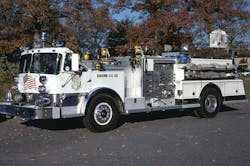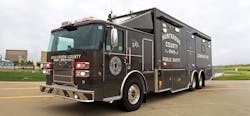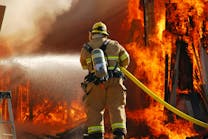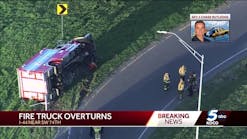Fire departments are being challenged to do more with less, particularly with respect to the financial resources required to provide for adequate staffing and training of our personnel. Capital projects for new fire stations and apparatus are being put off year after year. Nonetheless, fire suppression forces continue to provide emergency services to the communities they serve.
In all types of departments, staffing levels have been difficult to maintain, even in communities not directly impacted by the current recession. The days of riding with a full crew of eight to 10 personnel are gone in many places, with minimum staffing being the order of the day. Staffing relates directly to the number of seating positions required on each piece of apparatus and ultimately the size of the cab area itself and the cost of the apparatus. Both of these factors drive the wheelbase and overall length of the apparatus and have an impact on the turning radius and maneuverability of the vehicle. Several manufacturers have developed cab designs to address space and safety concerns.
Like any good student of history, we need a clear understanding of how cab designs and features developed over the years. Most departments have operated four-door-cab apparatus for some time; however, available space for crew seating, tools and equipment has changed dramatically just since the 1970s, when National Fire Protection Association (NFPA) standards covering apparatus design and configurations were not as comprehensive as the current 1901 standard. Today, it is not uncommon for both cabs and apparatus bodies to be 100 inches wide, with an average pumper exceeding 32 feet in length. In the past, “bigger was not always better” and resulted in more compact apparatus.
In the late 1960s, custom-cab design changed as diesel engines replaced gasoline power. Cabs produced during that period typically were 76 inches wide with an individual bucket-style seat for the driver together with a short bench seat for two personnel, including the officer. Two rear-facing seats, often referred to as “jump seats” or “buckets,” on either side of the engine enclosure were just 18 or 19 inches wide with little room to maneuver. As some open-cab apparatus were still being acquired, this restricted space in the jump seats was not much of a concern as elbow room and seating comfort, while minimal, was considered acceptable. These cab designs were distinctive with large painted fenders extending beyond the cab side panels. During the “war years,” many departments modified these open-cab units with makeshift plywood roofs and enclosures and consequently open-cab apparatus quickly fell out of favor with all but a few departments.
While four-door-cab apparatus were not required until the early 1990s, some departments, such as New York City, began to specify enclosed-cab apparatus as early as 1968. In 1971, the FDNY took delivery of 40 Mack CF pumpers equipped with enclosed four-door cabs to protect the crew. The CF cab was 92 inches wide on the exterior with 83 inches of interior space. Engineers at Mack realized space in the jump-seat area was at a premium and so designed an engine cover with angled side walls, which greatly increased the room for personnel riding in these positions. Before the advent of fully enclosed cabs, the engine box, which was fabricated from aluminum or steel tread plate, became a popular area to mount self-contained breathing apparatus (SCBA) and hand tools.
Departments that staffed apparatus with five or six personnel often had these individuals ride in a seated or standing position opposite the rear-facing jump seats. Certainly, these riding positions where not safe as personnel were exposed to weather, traffic and other hazards. The popularity of this type of seating position led to the development of safety bars, gates and doors to protect personnel riding in these locations. Apparatus manufacturers that built custom cabs, such as Crown, Hahn, Maxim, Peter Pirsch and Ward LaFrance, developed wider-profile four-door cabs to increase space for the driver, officer and crew areas, with seating for up to six personnel. Diesel engines in a V-style configuration required more room inside the engine enclosure, which also impacted available space in the jump-seat area. Higher-powered engines at that time were in the range of 450 horsepower, which required larger radiators and cooling packages to provide optimum performance.
Cab-forward apparatus continued to be the predominant design until 1983, when Spartan Motors introduced the Gladiator chassis, which put the engine up front between the driver’s and officer’s seats. This design provided adequate cooling for high-horsepower diesel engines and opened up the entire rear cab area for multiple seating configurations. Shortly thereafter, Young Fire Equipment in Lancaster, NY, introduced the Crusader II mid-engine chassis. The first Young-built four-door, raised-roof cab was delivered to the Bailey’s Cross Roads Fire Company in Virginia on a 175-inch wheelbase with a clutch-controlled fire pump located under the cab floor. By removing the engine from the cab area, more space was available in the front for map books, computer terminals and other equipment.
While some in the apparatus industry did not believe these alternative engine designs would be popular in the tradition-bound fire service, within a few years other manufacturers were offering mid- and rear-engine chassis to increase crew-seating options. Most notably, Emergency One (now E-ONE) in 1985 introduced the Hush rear-engine chassis, which allowed seating for up to 10 personnel. These cabs were 94 to 96 inches wide with virtually no fender area to maximize the available space inside the crew seating area. For the first time, fire departments had the option to provide different seating arrangements and were not restricted to just four fixed seats.
At that time, engine and pump technology was introducing computer and electronic components that required chassis and cab space for mounting and maintenance access. Cab width had for the most part remained constant at 94 to 96 inches for years with minimal aesthetic exterior changes. Some departments operating with narrow fire station clearances recognized that while wider cabs provided improved crew space, they had difficulty maneuvering in tight locations.
NFPA 1901, in Section 14.1.9, provides guidance on minimum dimensions required for seating arrangements inside the cab. Each seating space must have a cushion at least 18 inches wide and 15 inches deep from the edge of the cushion to the vertical face of the seat back. In addition, each seating position must have a minimum of 22 inches of width at the shoulder level. These dimensions are being studied and validated based on a national anthropometric study of fire personnel conducted in cooperation with the National Fallen Firefighters Foundation (NFFF). The results of this several-year study will impact apparatus seating and seatbelt design, protective gear, step heights and many other aspects of our daily activities. Preliminary data from the study indicate the seat width to accommodate the 99th-percentile 2011 firefighter must be 28 inches. That is the width needed to accommodate a modern-day bunkered-up firefighter, and it is going to have a dramatic impact on cab design.
As a part of specification development, the apparatus committee should review department standard operating guidelines (SOGs),including staffing and assignments for each riding position. Just because you can specify a custom cab with seating for eight to 10 personnel is no reason to require this arrangement for your next apparatus unless your department can regularly staff it at this level. The number of seating positions on custom-chassis apparatus impacts a number of areas, including front axle, suspension and tire ratings, cab size and ultimately overall length.
Following are questions to answer before designing a cab:
- How many personnel normally will be assigned or will ride on this unit?
- What map books, computer and resource materials must be readily available for the officer?
- Where will protective gear be stored during non-emergency responses?
- What tools and equipment will be mounted and secured in the cab or an adjacent area?
Responses will provide insight as to what cab configuration will most benefit the department in terms of efficient use of space without compromising safety. Future articles will review current cab designs and discuss the importance of clear vision for the driver and officer seating positions, mounting of tools and equipment, stepping surfaces and other safety considerations.
TOM SHAND, a Firehouse® contributing editor, is a 36-year veteran of the fire service and works with Michael Wilbur at Emergency Vehicle Response, consulting on a variety of fire apparatus and fire department master-planning issues. MICHAEL WILBUR, a Firehouse® contributing editor, is a lieutenant in the New York City Fire Department, assigned to Ladder Company 27 in the Bronx, and has served on the FDNY Apparatus Purchasing Committee. He consults on a variety of apparatus-related issues around the country. For further information, access his website at www.emergencyvehicleresponse.com.








